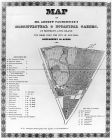Alley
Alley is used in the American setting to describe various forms of walks bordered by plantings on either side, and often appears alongside avenue and walk in treatises and descriptions (see Avenue and Walk).[1] General dictionaries, such as those by Thomas Sheridan and Noah Webster, even define walks and alleys to be synonymous. Despite their similar meanings, however, the term “walk” was more broadly defined in specialist literature; walks occur in a variety of settings outside the garden (for example, rope walks). Alley, despite its frequent use denoting a narrow passage in a town, has a more particular association with the designed landscape than either avenue or walk, having been derived from the French verb aller (to go), which was often associated in British and American gardening treatises with French formal gardens.
The repeated use of the phrase “walks and alleys” in American garden writing suggests that there was a distinction between the two terms, although that nuance of meaning is neither clear nor consistent. In the late seventeenth century, French treatise author Jean de La Quintinie often used the terms “alley” and “walk” interchangeably, and distinguished alleys as more narrow than avenues. Other treatise writers find the main criteria of an alley to be a walkway formed between two rows of plantings, defined by either low borders, such as in Lewis Beebe’s description of flowers lining the alleys at Lemon Hill in Philadelphia, or by tall, mature shade trees forming an enclosing canopy. This latter definition was exemplified at New Haven Burying Ground (as described by Timothy Dwight in 1796), André Parmentier’s horticultural and botanical garden, with its alleys of nectarine, peach, pear, apple, plum, and cherry trees [64], and Thomas Jefferson’s plantation, Monticello [72]. In contrast to the treatises, usage examples suggest that alley referred to walkways of all sizes planted on either side, from the pedestrian paths of Gray’s Garden in Philadelphia and Jefferson’s six-foot-wide “allies” between grass plots at Monticello to the alley wide enough for two carriages to pass at the New Haven Burying Ground. The “Tenpin Alley” in the pleasure grounds of the Pennsylvania Hospital for the Insane is an example of the use of the term to describe a site for bowling that looks completely different from the more common garden element, the bowling green (see Bowling green) [1097].
Alleys also varied in their configuration. Like walks, they included straight, curved, and zig-zagged designs. An avenue was often planted on either side and was generally straight. An alley, on the other hand, was associated both with the geometric regularity of the ancient style and, as in Parmentier’s usage, with descriptions of winding or serpentine walks in a “modern,” more naturalistic garden (compare with Ancient style). It is in this latter context that the Rev. Manasseh Cutler’s description of the State House Yard, Philadelphia, cites Hogarth’s “Line of Beauty,” an allusion to mid-eighteenth-century aesthetic theory (see Landscape gardening and Picturesque).
In any configuration, alleys functioned much like their counterparts, avenues and walks, in directing views in the landscape and in controlling circulation patterns. Like avenues, straight alleys were used to create an impressive approach to the main house’s front entrance and to direct a viewer’s gaze toward a focal point or vista. As G. Gregory (1816) advised, the illusion of depth could be further enhanced by making the alley wider at the entrance than at the termination. Like serpentine walks, a curvilinear alley led garden visitors gradually through the landscape, with each turn revealing a new view or perspective, as conveyed by Cutler’s 1787 description of Gray’s Tavern in Philadelphia.
Treatises describe alleys as usually laid with grass or gravel. The surfaces of American alleys are most commonly described and depicted as gravel, or rolled dirt, although an 1867 description of the garden of Charles Norris in Philadelphia mentions “graveled and grass walks and alleys.” In many parts of America, the climate was less suited to growing turf than in England, and the surface material was likely selected for its durability, drainage, ease of maintenance, availability, and cost, as well as aesthetic concerns. Archaeological examples suggest packed dirt (as at Arthur Allen’s Virginia home, Bacon’s Castle), shell, and gravel were used, although none of the walkways at these sites has been associated with the term “alley.” Based on extensive excavations at Williamsburg, Va., the quintessential image of the colonial revival garden, the brick walk, does not appear to have been used there (see Walk).
Images
Inscribed
Map of Mr. Andrew Parmentier's Horticultural and Botanic Garden, at Brooklyn, Long Island, Two Miles From the City of New York, 1828, Brooklyn Historical Society, Brooklyn, NY
Notes
- ↑ In American landscape writing the term “alley” was used most often in its anglicized rather than its French spelling (allée).


